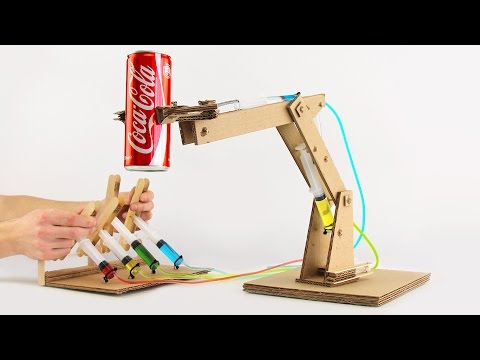13.1: Biophysical Model of the Arm
- Page ID
- 17826
Project Goals
- Use hands-on experience to reinforce physics concepts covered so far
- Jump cognition levels to create
- Practice critical thinking and the scientific process
- Have fun
Project Description
Build a scale articulating model of the human arm from the shoulder to the wrist. The model will include the lower arm, upper arm, elbow joint, biceps and triceps muscles and associated tendons. The model will be made out of cardboard, glue, twist ties and wooden dowels. The articulation of muscles will be done using syringes and tubing to form hydraulic actuators and twist ties will serve as tendons in similar fashion to the process seen in the following video:
Your project assess the concepts listed below and your project grade will be determined according to the criteria listed under each concept. The project is worth 15 points overall, and the distribution of points among the criteria are listed under each concept.
- Scientific Method: Creation process is well documented in a typed project report with the sections listed in bold below:
- DESIGN
- Neat documentation of design considerations and how they relate to concepts covered in class = 1pt
- Neat scale diagram of your design before building begins. Must include labels and dimensions. = 1pt
- BUILD
- Neat documentation of issues encountered during build = 1pt
- Neat documentation of solutions to build issues and changes to design = 1pt
- TEST
- Neat documentation of issues encountered during testing of design =1pt
- REDESIGN
- Neat documentation of solutions to testing issues and changes to design = 1pt
- Neat final updated scale diagram = 1pt
- Unit Conversion: The model is a 2:3 scale size of a human arm.
- Scaled 2:3 = 2pts
- Proportionally scaled, but not 2:3 = 1pt
- Forces and Torques: The model is capable of curling at least 1:100 the weight that a human arm can curl.
- Curls at least 1:100 scale weight = 2 pts
- Curls weight, but not 1:100 scale weight = 1pt
- Levers: The model actuates with the same range of motion (in terms of elbow angle) as the human arm.
- Articulates full human range of motion = 2 pts
- Articulates, but not full human range of motion= 1pt
- Stability: The model does not tip over under the 1:100 scale load.
- Remains standing = 1pt
- Strength of Materials: The model materials do not fracture, rupture, or otherwise fail under the 1:100 load.
- No failure, fracture or rupture = 1pt
Additional Information to Consider:
- You may use any resource you like for guidance, however only students in you group may work on your model or add to the documentation AND you must cite your sources in your project report.
- You don’t have to build the control levers, you can just hold and operate your two control syringes.
- Your model does not need to rotate like the one in the example video.
- Do not build a hand, we will hang a weight from the end of your model’s forearm for the testing phase.
- You do not have to generate your diagrams on the computer unless you want to. You can draw them by hand and attach them to your report as long as they are still neat, well labeled, properly scaled, and the dimensions are indicated.
- Your project will receive a group score, however students not actively participating and contributing will not receive credit for the project.
- You will be able to go through as many rounds of design/build/test as you would like within the time allotted for this project.
- All projects must have their final evaluation on or before the last day of the period allotted for the project.
- Don’t hesitate to ask your instructor for help or ask clarification question regarding the project expectations.



